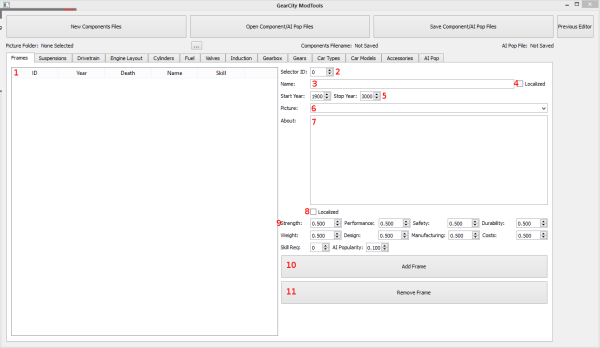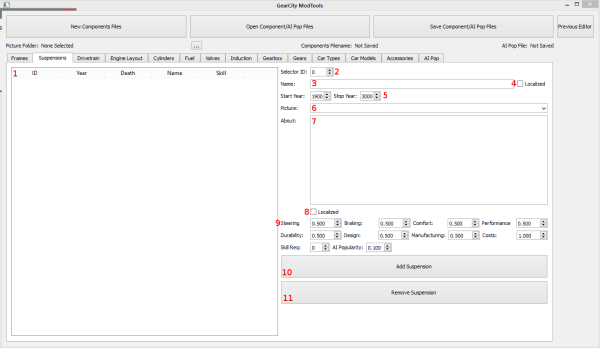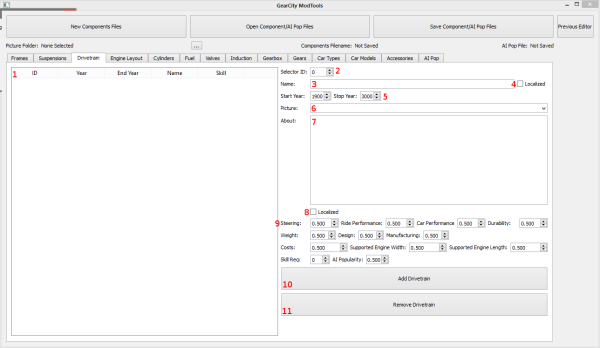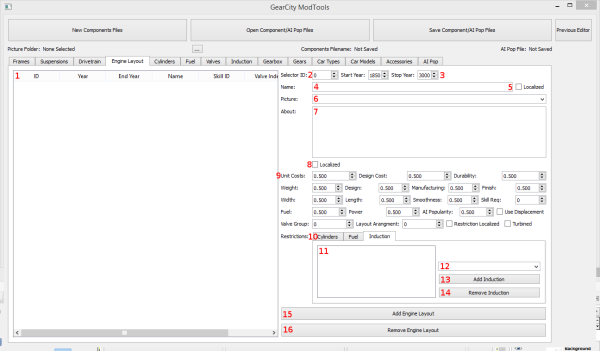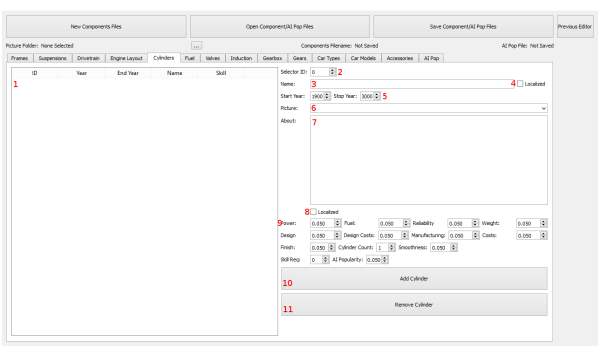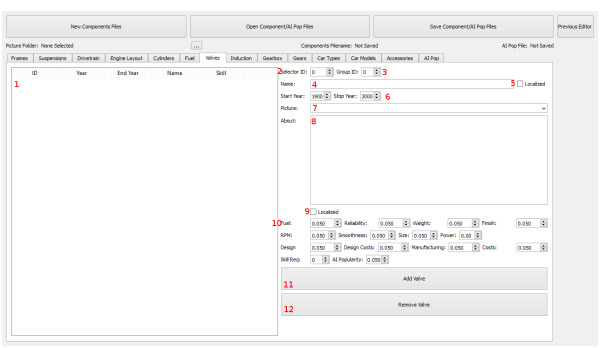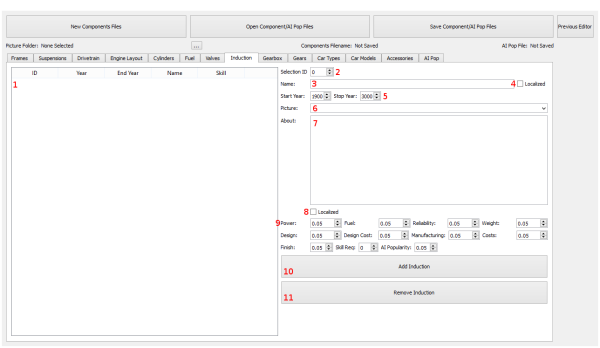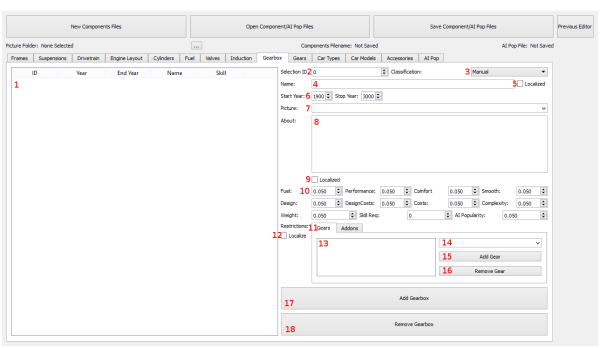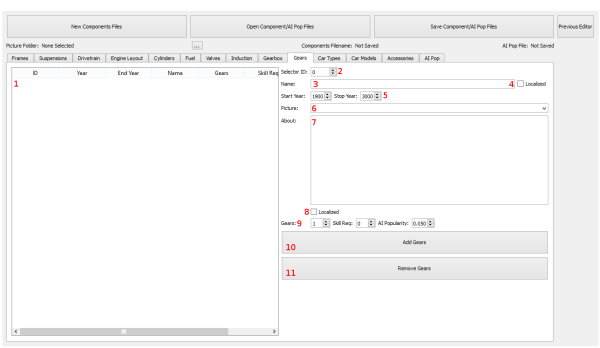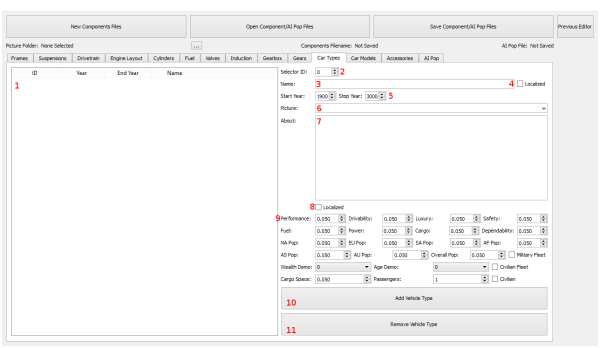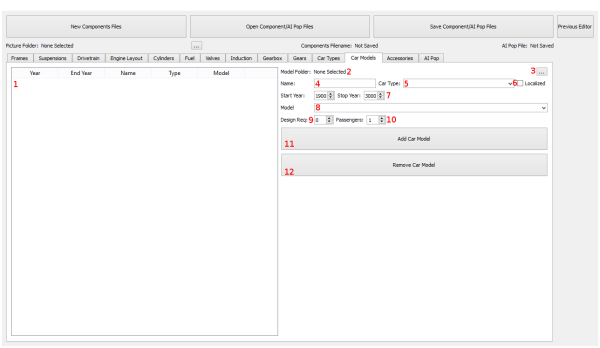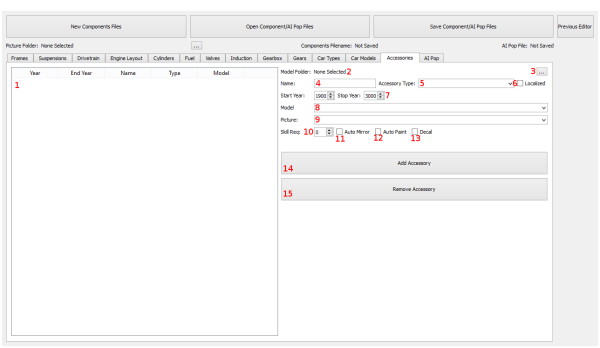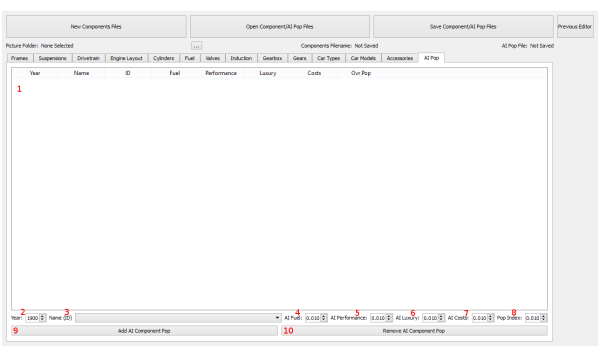Table of Contents
コンポーネントエディター
GearCityでは、車両はシャーシ、エンジン、ギアボックスの3つのコンポーネントで構成されています。これらのコンポーネントはそれぞれサブコンポーネントを持っています。これらのサブコンポーネントのデータは Components.xml ファイルに保存されます。また、Components.xmlファイルには、ビークルタイプとデータ、ビークル画像のエントリー、アクセサリ画像のエントリーも含まれています。
コンポーネントエディターは、AIサブコンポーネント選択用の静的人気も編集できます。これは別のファイルですが、サブコンポーネントのデータが含まれているため、同じエディターを使用します。
Components.xmlファイルとComponentsStartingPop.xmlファイルはどちらもデフォルトのゲームファイルであり、直接変更するべきではありません。MODシステムを使って、これらのファイルを上書きしてください。こうすることで、ゲームファイルを壊さずに済みますし、次回のゲームアップデート時に作業が失われることもありません!詳しくは:MODファイルの作り方
コンポーネントエディターを開く
コンポーネントエディターにアクセスするには、MOD ツールを開く必要があります。MODツールへのアクセス方法が分からない場合は、MODツールの開き方を参照してください。
コンポーネントエディターは、MODツールのMain Menuの中央列、「Mod Data Tools」のすぐ下にあります。「Components Editor.」と書かれたボタンをクリックします。
エディター
コンポーネントエディターには、ゲーム内の各サブ・コンポーネント・タイプ用の複数のサブ・エディターがあります。さらに車種、画像、AI用のエディターもあります。これらのエディターに加えて、すべてのサブエディターで使用される画像ファイルなどのいくつかの 「全般 」設定があります。
以下の図は、コンポーネントエディターの上部で、エディターの全般設定と、各サブエディタに移動するためのタブがあります。
- エディタで既存のデータをクリアして、新しい Components.xml と ComponentsStartingPop.xml ファイルを作成します。
- 既存の Components.xml と ComponentsStartingPop.xml ファイルを開きます。両方のファイルを同時に開く必要はありません。たとえば、components.xml ファイルを編集するだけの場合は、[Open Components File] ボタンをクリックし、Components.xml を選択します。ComponentsStartingPop.xml ファイルを開くように促されたら、キャンセルをクリックします。Components.xml ファイルが読み込まれ、AI Pop エディタは空白になります。
- これにより、Components.xmlファイルとComponentsStartingPop.xmlファイルが保存されます。1つのファイルのみを保存する場合は、保存したくないファイルのプロンプトをキャンセルできます。たとえば、ComponentsStartingPop.xml ファイルのみを編集している場合、「Save Components/AI Pop Files」 をクリックし、Components.xml ファイルを保存するプロンプトが表示されたらキャンセルをクリックします。
- 前のエディターまたはメインメニューに戻ります。
- サブコンポーネント、車種、アクセサリーなどのすべての.ddsピクチャを含むフォルダを開きます。MODを作成する場合、これらのファイルはサブディレクトリを作らず、MODのComponentImages.zipファイルに入れる必要があります。MODの作り方についてはMODファイルの作り方を、DDSテクスチャの作り方についてはDDSテクスチャを参照してください。
- 編集中のコンポーネントファイルが表示されます。ファイルを開いた場合、ファイル名が表示されます。ファイルを保存した場合は、保存名が表示されます。
- 編集中の ComponentsStartingPop ファイルが表示されます。ファイルを開いた場合は、ファイル名が表示されます。ファイルを保存した場合は、保存名が表示されます。
- フレームタブでは、シャーシのフレームサブコンポーネントを追加、編集、または削除できます。
- サスペンションタブ では、シャーシのサスペンションサブコンポーネントの追加、編集、削除ができます。
- ドライブトレインタブ では、シャーシのドライブトレインレイアウトの追加、編集、削除ができます。
- エンジンレイアウトタブ では、エンジンのエンジンレイアウトを追加、編集、削除できます。
- シリンダータブ では、エンジンのシリンダーサブコンポーネントの追加、編集、削除ができます。
- 燃料タブ では、エンジンの燃料タイプを追加、編集、削除できます。
- バルブタブ では、エンジンのバルブトレインサブコンポーネントの追加、編集、削除ができます。
- 過給機タブ では、エンジンのエア過給機サブコンポーネントの追加、編集、削除ができます。
- ギアボックスタブ では、ギアボックスタイプの追加、編集、削除ができます。
- ギアタブ では、ギアボックスのギアサブコンポーネントの追加、編集、削除ができます。
- カータイプタブ では、ゲームから車種を追加、編集、削除できます。
- カーモデルタブ では、車両のボディモデル(シェル、メッシュなどとも呼ばれる)をゲームに追加、編集、削除できます。
- アクセサリタブ では、アクセサリ(タイヤ、ヘッドライトなど、ボディシェルに追加できるもの)をゲームに追加、編集、削除できます。
- AIPop(人気度)タブ では、AIコンポーネントの選択人気値の追加や編集ができます。これは別のファイルに保存されますが、コンポーネントエディータのデータに依存するため、エディターはコンポーネントエディターに含まれています。
フレーム
このタブでは、シャーシのフレームのサブコンポーネントを編集できます。次の図は、エディターのコンポーネントがどこにあるかを示しています。フレームの変数セクションには、各変数の効果に関する詳細な説明があります。
- これは現在エディター内にあるフレームサブコンポーネントのリストです。このリストからフレームを選択すると、その情報が右側にロードされます。
- これはTurnEvents.xmlファイルで使用されるSelector IDです。Turn Events Editorを使用して、時間の進行に応じてコンポーネントの人気値を変更することができます。
- フレームタイプの名前です。ローカライズする場合は、ローカライズファイルのIDの番号を指定します。
- このボックスをチェックすると、ゲームはローカライズファイルのテキストをフレーム名として使用します。ゲームはローカライズID番号にフレーム名の値を使用します。
- 開始年は、そのフレームが試合で使用できるようになる年です。終了年は、フレームがゲームで使用できる最後の年です。
- フレームの選択肢画像として使用する画像をドロップダウンから選択します。これらのファイルを含むフォルダは、この画像の#5で設定する必要があります。適切な画像の作り方については DDS Texturesを参照してください。
- ここにフレームの説明を書きます。ローカライズシステムを使用する場合は、ローカライズIDの番号を記入します。
- #7の 「About」をローカライズする場合はチェックを入れてください。ローカライズされた場合、ゲームはボックス内のID番号のテキストを探し、そのテキストを説明文として使用します。
- これらはフレーム固有の変数です。詳しくはフレームの変数を参照してください。
- フレームのリストにフレームを追加または編集します。
- 選択したフレームをフレームリストから削除します。
サスペンション
このタブでは、シャーシのサスペンションサブコンポーネントを編集することができます。次の図は、エディターのコンポーネントがどこにあるかを示しています。サスペンションの変数セクションには、各変数の効果の詳細な説明があります。
- このリストは現在エディターにあるサスペンションのサブコンポーネントのリストです。このリストからサスペンションを選択すると、その情報が右側にロードされます。
- これは TurnEvents.xml ファイルで使用される選択ID です。ターンイベントエディターを使用して、時間の進行に応じてコンポーネントの人気値を変更することができます。
- サスペンションタイプの名前です。ローカライズする場合は、ローカライズファイルのIDの番号になります。
- このボックスにチェックを入れると、ゲームはローカライズファイルのテキストをサスペンションの名前として使用します。ローカライゼーションID番号にはサスペンション名の値が使用されます。
- 開始年は、サスペンションがゲームで使用できるようになる年です。終了年とは、サスペンションがゲーム内で使用できる最後の年です。
- サスペンションの選択画像として使用する画像をドロップダウンから選択します。これらのファイルを含むフォルダは、#5 in this imageで設定する必要があります。適切な画像の作り方については DDS Texturesを参照してください。
- ここにサスペンションの説明を書きます。ローカライズシステムを使用している場合は、ローカライズIDの番号が入ります。
- #7の 「About」をローカライズする場合はチェックを入れてください。ローカライズされた場合、ゲームはボックス内のID番号のテキストを探し、そのテキストを説明文として使用します。
- これらはサスペンション固有の変数です。詳細はサスペンションの変数を参照してください。
- サスペンションのリストにサスペンションを追加または編集します。
- 選択したサスペンションをサスペンションリストから削除します。
ドライブトレイン
このタブでは、シャーシのドライブトレインを編集することができます。次の図は、エディターのコンポーネントがどこにあるかを示しています。ドライブトレインの変数セクションセクションには、各変数の効果の詳細な説明があります。
- 現在エディターに登録されているドライブトレインのリストです。このリストからドライブトレインを選択すると、その情報が右側にロードされます。
- これはTurnEvents.xmlファイルで使用される選択IDです。ターンイベントエディターを使用して、時間の進行に応じてコンポーネントの人気値を変更することができます。
- ドライブトレインタイプの名前。ローカライズする場合は、ローカライズファイルのIDの番号を指定します。
- このボックスにチェックを入れると、ゲームはローカライズファイルのテキストをドライブトレインの名前として使用します。ゲームはローカライズID番号にドライブトレイン名の値を使用します。
- 開始年は、ドライブトレインがゲームで使用できるようになる年です。終了年は、そのドライブトレインがゲームで使用できる最後の年です。
- ここにドライブトレインの説明を記入する。ローカライズシステムを使用している場合は、ローカライズIDの番号を記入してください。
- #7の「About」をローカライズする場合は、このボックスにチェックを入れてください。ローカライズされた場合、ゲームはボックス内のID番号のテキストを探し、そのテキストを説明文として使用します。
- これらはドライブトレイン固有の変数です。詳細はドライブトレインの変数を参照してください。
- ドライブトレインのリストにドライブトレインを追加または編集します。
- ドライブトレインのリストから選択したドライブトレインを削除します。
エンジン レイアウト
このタブでは、エンジンのサブコンポーネントであるエンジン レイアウトを編集することができます。次の図は、エディターのコンポーネントがどこにあるかを示しています。エンジンの変数セクションには、各変数の効果の詳細な説明があります。
- 現在エディター内にあるエンジンレイアウトのリストです。このリストからレイアウトを選択すると、右側にその情報がロードされます。
- これはTurnEvents.xmlファイルで使用される選択IDです。Turn Events Editorを使用して、時間の進行に応じてコンポーネントの人気値を変更することができます。
- 開始年は、エンジンレイアウトがゲームで使用できるようになる年です。終了年は、そのエンジンレイアウトがゲームで使用できる最後の年です。
- エンジンレイアウトの種類名。ローカライズする場合は、ローカライズファイルのIDの番号を指定します。
- このボックスにチェックを入れると、ローカライズファイルのテキストがエンジンレイアウトの名前として使用されます。ゲームでは、ローカライズ ID 番号にエンジン レイアウト名の値が使用されます。
- エンジンレイアウトの選択画像として使用する画像をドロップダウンから選択します。これらのファイルを含むフォルダは、この画像の#5で設定する必要があります。適切な画像の作り方については、 DDS Texturesを参照してください。
- エンジンレイアウトの説明をここに書きます。ローカライズシステムを使用する場合は、ローカライズIDの番号を記述します。
- #7の 「About」をローカライズする場合はチェックを入れてください。ローカライズされた場合、ゲームはボックス内のID番号のテキストを探し、そのテキストを説明文として使用します。
- これらはエンジンレイアウトに固有の変数です。詳細はエンジンレイアウトの変数を参照してください。
- これは制限システムです。エンジンレイアウトは、エンジンが使用でき るシリンダー、燃料タイプ、過給機を制限します。各タブには,タブ選択にラベル付けされたサブコンポーネントタイプの制限システムが含まれます。
- 選択されたタブの現在の制限を一覧表示します。エンジンレイアウトでは、これらのサブコンポーネントしか使用できません。名前がローカライズされている場合、数字が表示されることがあります。制限のローカライズがローカライズのためのレイアウトで有効になっていなければならないことに注意してください。ローカライゼーションIDが10000以下や数字以外のエントリーは無視されます。これは、ローカライズされたサブコンポーネントとローカライズされたサブコンポーネントを混ぜて使用できるようにするためです。
- これは、制限に追加できるサブコンポーネントのリストです。
- これは、この画像の#11のエンジンレイアウトで使用できるサブコンポーネントのリストから、選択したサブコンポーネントを削除します。
- これにより、エンジンレイアウトがエンジンレイアウトのリストに追加されます。
- エンジンレイアウトのリストから、選択したエンジンレイアウトを削除します。
シリンダー
このタブでは、エンジンのシリンダーデータを編集することができます。次の図はシリンダーエディターの様々な部分を示しています。シリンダーの変数のセクションには、各変数の効果の詳細な説明があります。
- これは現在エディター内にあるシリンダーのリストです。このリストからシリンダーを選択すると、その情報が右側にロードされます。
- これはTurnEvents.xmlファイルで使用される選択IDです。Turn Events Editorを使用して、時間の進行に応じてコンポーネントの人気値を変更することができます。
- シリンダータイプの名前。ローカライズする場合は、ローカライズファイルのIDの番号を指定します。
- このボックスにチェックを入れると、ゲームはローカライズファイルのテキストをシリンダー名として使用します。ゲームはローカライズID番号にシリンダー名の値を使用します。
- 開始年は、シリンダーがゲームで使用できるようになる年です。終了年は、シリンダーがゲームで使用できる最後の年です。
- ここにシリンダーの説明を書きます。ローカライズシステムを使用している場合は、ローカライズIDの番号を記入してください。
- #7の「About」をローカライズする場合は、このボックスにチェックを入れてください。ローカライズされた場合、ゲームはボックス内のID番号のテキストを探し、そのテキストを説明文として使用します。
- これらはシリンダー固有の変数です。詳細はシリンダーの変数を参照してください。
- シリンダーのリストにシリンダーを追加または編集します。
- 選択したシリンダーをシリンダーリストから削除します。
燃料
このタブでは、エンジンの燃料データを編集することができます。次の画像は燃料エディターの様々な部分を示しています。燃料の変数セクションには、各変数の効果の詳細な説明があります。
- 現在エディターに登録されている燃料のリストです。このリストから燃料を選択すると、その情報が右側にロードされます。
- これはTurnEvents.xmlファイルで使用される選択IDです。ターンイベントエディターを使用して、時間の進行に応じてコンポーネントの人気値を変更することができます。
- 燃料タイプの名前です。ローカライズする場合は、ローカライズファイルのIDの番号を指定します。
- このボックスにチェックを入れると、ゲームはローカライズファイルのテキストを燃料の名前として使用します。ローカライズID番号には燃料名の値を使用します。
- 開始年は、燃料がゲームで使用できるようになる年です。終了年は、その燃料がゲーム内で使用できる最後の年です。
- ここに燃料の説明を書きます。ローカライズシステムを使用している場合は、ローカライズIDの番号が入ります。
- #7の 「About 」をローカライズする場合はチェックを入れてください。ローカライズされた場合、ゲームはボックス内のID番号のテキストを探し、そのテキストを説明文として使用します。
- これらは燃料に固有の変数です。詳細は燃料の変数を参照してください。
- 燃料を燃料リストに追加または編集します。
- 選択した燃料を燃料リストから削除します。
バルブ
このタブでは、エンジンのバルブトレインデータを編集することができます。次の画像は、バルブエディターの様々な部分を示しています。バルブの変数のセクションには、各変数の効果の詳細な説明があります。
- このリストは現在エディターにあるバルブのリストです。このリストからバルブを選択すると、その情報が右側にロードされます。
- これはTurnEvents.xmlファイルで使用される選択IDです。ターンイベントエディターを使用して、時間の進行に応じてコンポーネントの人気値を変更することができます。
- これがグループ ID です。バルブグループは、エンジンレイアウトで使用可能なバル ブを選択するために使用されます。バルブ項目は1つのグループにのみ属することができます。したがって、グループ内のすべてのバルブを使用しないエンジンレイアウトを使用する場合は、新しいグループIDに属するバルブ項目を重複して作成する必要があります。
- バルブトレインのタイプ名です。ローカライズする場合は、ローカライズファイルのIDの番号を指定します。
- このボックスにチェックを入れると、ゲームはローカライズファイルのテキストをバルブ名として使用します。ゲームは、ローカライズID番号にバルブ名の値を使用します。
- 開始年は、そのバルブがゲームで使用できるようになる年です。終了年は、そのバルブがゲームで使用できる最後の年です。
- ここにバルブトレインの説明を記入する。ローカライズシステムを使用している場合は、ローカライズIDの番号を記入してください。
- #7の「About」をローカライズする場合は、このボックスにチェックを入れてください。ローカライズされた場合、ゲームはボックス内のID番号のテキストを探し、そのテキストを説明文として使用します。
- これらはバルブ固有の変数です。詳細はバルブの変数を参照してください。
- バルブのリストにバルブを追加または編集します。
- バルブのリストから選択したバルブを削除します。
過給機
このタブでは、エンジンの過給機システムデータを編集できます。次の図は、過給機エディターのさまざまな部分を示しています。過給機の変数セクションには、各変数の効果の詳細な説明があります。
- これは現在エディター内にある過給機システムのリストです。このリストから過給機システムを選択すると、その情報が右側にロードされます。
- これはTurnEvents.xmlファイルで使用される選択IDです。ターンイベントエディター を使用して、時間の進行に応じてコンポーネントの人気値を変更することができます。
- 過給機システムの名前です。ローカライズする場合、これはローカライズファイルの ID の番号でなければなりません。
- このボックスをチェックすると、ゲームはローカライズファイルのテキストを過給機システムの名前として使用します。ゲームはローカライズ ID 番号に過給機システム名の値を使用します。
- 開始年は、過給機システムがゲームで使用できるようになる年です。終了年は、過給機システムがゲームで使用できる最後の年です。
- ここに燃料の説明を書きます。ローカライズシステムを使用している場合は、ローカライズIDの番号が入ります。
- #7の「About」をローカライズする場合はチェックを入れてください。ローカライズされた場合、ゲームはボックス内のID番号のテキストを探し、そのテキストを説明文として使用します。
- これらは、過給機システムに固有の変数です。詳細は過給機の変数を参照してください。
- 過給機システムをリストに追加または編集します。
- 選択した過給機システムをリストから削除します。
ギアボックス
このタブではギアボックスを編集することができます。次の画像は、エディターの構成要素がどこにあるかを示しています。ギアボックスの変数セクションには、各変数の効果の詳細な説明があります。
- 現在エディターにあるギアボックスのリストです。このリストからギアボックスを選択すると、その情報が右側にロードされます。
- これは TurnEvents.xml ファイルで使用される選択 ID です。ターンイベントエディター を使用して、時間の進行に応じてコンポーネントの人気値を変更できます。
- これにより、ギアボックスがマニュアルかオートマチックかを選択できます。これは、ゲームで使用されるさまざまな計算に影響します。
- ギアボックスのタイプ名です。ローカライズする場合は、ローカライズファイルのIDの番号を指定します。
- このボックスをチェックすると、ゲームはローカライズファイルのテキストをギアボックスの名前として使用します。ゲームはローカライズID番号にギアボックス名の値を使用します。
- 開始年は、ギアボックスがゲームで使用できるようになる年です。終了年は、ギアボックスがゲームで使用できる最後の年です。
- ギアボックスの説明をここに記入します。ローカライズシステムを使用している場合は、ローカライズIDの番号を記入してください。
- #7の「About」をローカライズするには、このボックスにチェックを入れる。ローカライズされた場合、ゲームはボックス内のID番号のテキストを探し、そのテキストを説明文として使用します。
- これらはギアボックス固有の変数です。詳細はギアボックスの変数を参照してください。
- これは制限システムです。ギアボックスタイプは、ギアボックスが使用できるギアやアドオン機能を制限することができます。各タブには、タブ選択にラベル付けされたサブコンポーネントタイプの制限システムが含まれています。
- このボックスをチェックすると、制限されたギアがローカライズされているかどうかがゲームに表示されます。
- 選択されたタブの現在の制限を一覧表示します。ギアボックスはこれらのサブコンポーネントしか使用できません。名前がローカライズされている場合、数字が表示されることがあります。制限のローカライゼーションがローカライゼーションのレイアウトのために有効になっていなければならないことに注意してください。ローカライゼーションIDが10000以下や数字以外のエントリーは無視されます。これは、ローカライズされたサブコンポーネントとローカライズされたサブコンポーネントを混ぜて使用できるようにするためです。
- これは、制限に追加できるサブコンポーネントのリストです。
- これにより、ギアボックスが使用できるサブコンポーネントのリストから選択されたサブコンポーネントが削除されます(この画像の#11です)。
- ギアボックスのリストにギアボックスを追加します。
- ギアボックスのリストから選択したギアボックスを削除します。
ギア
このタブでは、ギアボックスのギア情報を編集することができます。以下の図はギアエディターの様々な部分を示しています。ギアの変数のセクションには、各変数の効果についての詳細な説明があります。
- 現在エディターにあるギアのリストです。このリストからギアを選択すると、右側にその情報がロードされます。
- これはTurnEvents.xmlファイルで使用される選択IDです。ターンイベントエディターを使用して、時間の進行に応じてコンポーネントの人気値を変更することができます。
- ギアの名前。ローカライズする場合は、ローカライズファイルのIDの番号を指定します。
- このボックスをチェックすると、ゲームはローカライズファイルのテキストをギアの名前として使用します。ゲームはギア名の値をローカライズID番号に使用します。
- 開始年は、そのギアがゲーム内で使用できるようになる年です。終了年は、そのギアがゲーム内で使用できる最後の年です。
- ここにギアの説明を書きます。ローカライズシステムを使用している場合は、ローカライズIDの番号を記入してください。
- #7の 「About」をローカライズする場合は、このボックスにチェックを入れてください。ローカライズされた場合、ゲームはボックス内のID番号のテキストを探し、そのテキストを説明文として使用します。
- これらはギアに固有の変数です。詳しくはギアの変数を参照してください。
- ギアをギアのリストに追加または編集します。
- 選択したギアをギアのリストから削除します。
車種
このエディターは、ゲーム内の車種を変更することができます。次の図は、エディターの構成要素がどこにあるかを示しています。車種の変数セクションには、各変数の効果についての詳細な説明があります。
- 現在エディターに登録されている車種のリストです。このリストから車種を選択すると、その情報が右側にロードされます。
- これはTurnEvents.xmlファイルで使用される選択IDです。ターンイベントエディターを使用して、時間の経過とともに車種の人気値を変更することができます。
- 車種名。ローカライズする場合は、ローカライズファイルのIDの番号を指定します。
- このボックスにチェックを入れると、ローカライズファイルのテキストが車種名として使用されます。ゲームはローカライズID番号に車種名の値を使用します。
- 開始年は、その車種がゲーム内で使用できるようになる年です。終了年は、その車種がゲームで使用できる最後の年です。
- ここに車種の説明を記入します。ローカライズシステムを使用している場合は、ローカライズIDの番号を記入してください。
- #7の「About」をローカライズする場合は、このボックスをチェックしてください。ローカライズされた場合、ゲームはボックス内のID番号のテキストを探し、そのテキストを説明文として使用します。
- これらは車種固有の変数です。詳細は車種の変数を参照してください。
- 車種リストに車種を追加または編集します。
- 車種リストから選択した車種を削除します。
車両のモデル
このエディターにより、ゲームに車体を追加することができます。また、どの車種にどの車種が合うのか、いつ使えるのかを定義することもできます。ゲーム内の各車両モデルは、ゲーム内の要件に準拠した.meshファイルを持っている必要があります。車体の作り方の詳細は、こちらを参照してください: 車両画像。
次の図は、エディターのパーツを分解したものです:
- これは現在ゲームに追加されている車体のリストです。このリストからモデルを選択すると、右の情報が読み込まれます。
- これは、ボディの.meshファイルが入っている選択したフォルダの名前です。右側のボタンでフォルダを選択します。フォルダが#8のドロップダウンに入力され、ボディを選択できるようになります。
- このボタンで.meshファイルのあるフォルダを選択できます。フォルダを選択すると、#8のドロップダウンにフォルダ内の.meshファイルが表示されます。ゲーム内で車体として使用するメッシュファイルを選択します。
- これが車体モデルの名前です。
- そのボディモデルが使用できる車種です。複数の車種に属する場合は、複数入力する必要があります。車種ドロップダウンには、車種タブに入力した内容が表示されます。
- このチェックボックスは、車種がローカライズされているかどうかをゲームに知らせます。車種名がローカライズされている場合、ゲームは車種名を使用するのではなく、ドロップダウンボックスでID番号を調べます。
- 開始年は、車体を選択できる年です。停止年とは、その車体を使用できる最後の年です。
- ゲーム内で使用する車体モデルファイルです。車体モデルの作り方については、車体画像を参照してください。このリストに入力する方法については、#2と#3を参照してください。
- この車体をアンロックするための設計条件です。現在、このシステムはゲームでは無効になっています。
- この車体が何人の乗客をサポートするかを設定できます。ゲームではこれを乗員数に使用します。
- 車両モデルリストに車両モデルを追加します。
- 選択した車両モデルを車両モデルリストから削除します。
アクセサリー
アクセサリーエディターです。車両モデルに適用され、車両モデルではない画像はすべてアクセサリーとみなされ、このエディターを使ってゲームに追加されます。以下の画像とリストでエディターのパーツを説明します。
- これは現在エディターにあるアクセサリーのリストです。このリストから項目を選択すると、右側の情報が読み込まれます。
- アクセサリーの画像を含む選択されたフォルダの名前です。#3のボタンでフォルダを選択します。
- アクセサリーの画像が入っているフォルダを選択します。これにより、#8と#9のドロップダウンボックスに.meshと.ddsファイルが自動的に入力されます。アクセサリーの作成方法の詳細については、アクセサリーの画像を参照してください。
- アクセサリーの名前です。
- アクセサリーの種類です。ゲームはこのアクセサリータイプ名に基づいてアクセサリーをグループ化します。新しいアクセサリータイプを作成する場合は、ドロップダウンにテキストを入力してください。既存のタイプを使用する場合は、ドロップダウンから選択できます。
- ローカリゼーションボックスがチェックされている場合、アクセサリータイプ名はローカリゼーションファイルのテキストを使用します。そのため、アクセサリータイプはローカリゼーションファイルのテキストのID番号でなければなりません。
- 開始年は、そのアクセサリーが使用可能になる年です。停止年は、そのアクセサリーが使用できなくなる年です。
- アクセサリーのメッシュまたはデカールddsのファイル名です。画像ディレクトリを選択した場合は、ドロップダウンにファイル名が入力されているはずです。そうでない場合は、名前を入力する必要があります(大文字と小文字が区別されます)。
- アクセサリーのサムネイル/アイコン画像です。プレイヤーが使用可能なアクセサリーの一覧を表示する際に使用されます。アートワークディレクトリを選択した場合、ドロップダウンにファイル名が入力されているはずです。そうでない場合は、ファイル名を入力する必要があります(大文字と小文字が区別されます)。
- アクセサリーをアンロックするために必要なスキルです。現在ゲーム内では無効になっています。
- このボックスにチェックを入れると、アクセサリーが自動的に複製され、車両のフロント軸上にミラーが配置されます。例えば、ゲーム内のデフォルトのミラーは、自動的に車両の両側に2つのミラーを配置します。
- このチェックボックスは、最後に選択されたペイントカラーでアクセサリーを自動的にペイントし、何も選択されていない場合は白でペイントします。
- これはゲームに対して、そのアクセサリーが「デカール」、つまり3Dモデルではなく2D画像であることを示します。デフォルトゲームでのこの例は、後期モデルのヘッドライトです。
- アクセサリーをアクセサリーリストに追加します。
- 選択したアクセサリーをアクセサリーリストから削除します。
AIPop(AI人気度)
このエディターでは、コンポーネントタイプのAI人気(またはAI選択優先度)を設定することができます。各人気値は、構築される車種に基づいてコンポーネントの選択に重みを与えます。例えば、ある車種のパフォーマンス重要度が高い場合。その場合、パフォーマンスAI人気値が高いコンポーネントは、パフォーマンスAI人気値が低いコンポーネントよりも多く選択されます。
次の図は、エディターの各パーツとその役割を説明したものです。
- AI人気度値を持つコンポーネントのリストです。このリストからコンポーネントを選択すると、以下の情報が読み込まれます。
- これはAI人気が有効になる年です。ゲームは2つの変更の間に値を補間します。
- これはコンポーネントの名前と選択IDです。このドロップダウン内の情報は、この画像のエディタータブから取得したものです。
- この値が高いほど、このコンポーネントは燃費の重要度が高い車種に選択される可能性が高くなります。
- この値が高いほど、パフォーマンス重視の評価が高い車種にこのコンポーネントが選択される可能性が高くなります。
- この数値が高いほど、高級感重視の評価が高い車種に選ばれやすくなります。
- この値が高いほど、富裕度が低い車種に選ばれやすくなります。
- この値が高ければ高いほど、すべての車種でこのコンポーネントが選ばれる可能性が高くなります。
- リストに人気値を追加します。
- リストから選択された人気値を削除します。
ファイルとその仕組み
サブコンポーネント、車種、車両アートワークはすべてcomponents.xmlファイルと呼ばれる1つのファイルで処理されます。AI人気度ファイルは、ComponentsStartingPopularity.xmlファイルを通してロードされます。これらのファイルの場所については、以下を参照してください:ファイルの場所
新しいセーブゲームを作成すると、ゲームはcomponents.xmlを読み込み、すべてのデータをセーブゲームデータベースに保存します。その後、components.xmlファイルはセーブゲームの残りの期間使用されません。そのため、components.xmlファイルを変更する場合は、新たにセーブゲームを行う必要があります。
その後、ゲームはComponentsStartingPop.xmlファイルを読み込み、その情報をデータベースに保存します。ただし、components.xml ファイルとは異なり、ゲームは新しい人気値を補間して保存するために、ゲーム年の終わりに ComponentsStartingPop.xml を読み込みます。しかし、ComponentsStartingPop.xmlファイルへの変更は、エントリーの年の値がヒットしたときにのみ有効になります。
変数
以下は、特定のコンポーネントの特性を調整するコンポーネントの変数です。+は、その評価または仕様が向上することを示します。-は、その評価または仕様が悪化することを示します。
フレーム
フレームは、自動車のさまざまな部品をつなぎ合わせる構造体です。そのため、フレームには車両にさまざまな影響を与える特性があります。各変数の影響について説明しようと思いますが、非常に詳細なデータは 「In-depth(詳細)」ウィキページを書くまで待たなければなりません。そのページが実装されたら、そこにリンクします。
| 名称 | 説明 | シャーシ効果 | 車両効果 |
|---|---|---|---|
| 強度 | 応力や重量に対するフレームの強さを表します。 | +強度 | +安全性、+ディペンダビリティ(信頼性)、+牽引力 |
| パフォーマンス | シャーシの操縦性、接地力、そしてグリップ力を最大化するためのねじれ応力への対応力を表します。 | +パフォーマンス | +横G、+ブレーキ、+安全性(横Gとブレーキによる)、+パフォーマンス、+運転性 |
| 安全性 | クランプルゾーン(クラッシャブルゾーンのこと)などのシャーシの安全設計や、車両への衝撃の吸収・分散性を表します。 | シャーシ評価への影響なし | +安全性 |
| 耐久性 | これは、フレーム設計が一般的にどれくらい長持ちするかということであり、長期にわたってどれだけのストレスに耐えられるかということです。 | +強度、+耐久性 | +安全性、+品質、+ディペンダビリティ(信頼性) |
| 重量 | デザインによっては、他のものよりも多くの重量を必要とする場合があります。この変数はフレームの重量を表します。値が大きいほど重いです。 | -製造要件、 -重量、 +強度 | -重量、 -パフォーマンス、 -燃費、 -運転性、 -横G、 -ブレーキ力、 -加速度、 -最高速度 |
| 設計評価 | この変数は、このフレームでのデザインの難易度を表します。値が大きいほど難しいです。 | -設計にかかる時間、-設計にかかる費用 | -設計にかかる時間、-設計にかかる費用 |
| 製造力 | このフレームの製造難易度を表します。値が大きいほど難しいです。 | -工場ラインあたりのユニット数、-ラインあたりのペナルティを受けないためには、より多くの工場の準備が必要。 | -工場ラインあたりのユニット数、-ラインあたりのペナルティを受けないためには、より多くの工場の準備が必要。 |
| コスト | フレームの費用です。数値が高いほど高くなります。 | -コスト | -コスト |
| Skill Req | これは、フレームをアンロックするために最低限必要なシャーシデザインのスキルポイントです。この値は 「開始」年を過ぎると自動的に減少します。 | -ロック解除条件 | 車両には影響しません。 |
| AI人気度 | AIコンポーネント人気度ファイルが存在しない場合、AIがこのアイテムを使用する可能性の基本パーセンテージです。 | シャーシには影響しません。 | 車両には影響しません。 |
サスペンション
サスペンションは、車両と車輪をつなぎ、車輪と路面をつないでおく支持構造です。サスペンションシステムのある種の特性は、車両にさまざまな影響を与えます。各変数の影響について説明しますが、非常に詳細なデータは 「In-depth(詳細)」ウィキページを書くまで待たなければなりません。それらのページが実装されたら、そこにリンクします。
| 名称 | 説明 | シャーシ効果 | 車両効果 |
|---|---|---|---|
| ステアリング | シャーシの運転性、操縦性、接地力に対するサスペンションの影響です。この数値が高いほど、一般的にパフォーマンス重視のサスペンションシステムを意味します。 | +快適性、 +パフォーマンス | +パフォーマンス、 +運転性、 +高級感 |
| ブレーキ力 | サスペンションが車両を停止させる際の効果を示します。数値が高いほどブレーキ力に優れています。 | +パフォーマンス | +ブレーキ力、 +安全性、 +パフォーマンス |
| 快適性 | サスペンションシステムが、段差や穴などの路面の障害物にどれだけ対応できるかを示します。サスペンションが快適であればあるほど、ドライバーは路面の問題に気づきにくくなります。 | +快適性 | +高級感、-設計要件 |
| パフォーマンス | サスペンションのパフォーマンスへの影響です。この値が高いほど、サスペンションは高速での操縦性に優れています。 | +パフォーマンス | +パフォーマンス、+運転性 |
| 耐久性 | サスペンションシステムが負荷にどれだけ耐えられるか、部品がどれだけ長持ちするかなどを示します。 | +強度、+耐久性 | +ディペンダビリティ(信頼性)、+品質 |
| 設計評価 | このフレームでのデザインの難易度を表す変数です。値が高いほど難しいです。 | -設計にかかる時間、-設計にかかる費用 | -設計にかかる時間、-設計にかかる費用 |
| 製造力 | このフレームの製造難易度を示します。数値が高いほど製造が難しいです。 | -工場ラインあたりのユニット数、-ラインあたりのペナルティを受けないためには、より多くの工場の準備が必要。 | -工場ラインあたりのユニット数、-ラインあたりのペナルティを受けないためには、より多くの工場の準備が必要。 |
| コスト | フレームの費用です。数値が高いほど高くなります。 | -コスト | -コスト |
| Skill Req | これは、フレームをアンロックするために最低限必要なシャーシデザインのスキルポイントです。この値は 「解禁」年を過ぎると自動的に減少します。 | -ロック解除条件 | 車両には影響しません。 |
| AI人気度 | AIコンポーネント人気度ファイルが存在しない場合、AIがこのアイテムを使用する可能性の基本パーセンテージです。 | シャーシには影響しません。 | 車両には影響しません。 |
ドライブトレイン
ドライブトレインは、車体に対するエンジンと駆動輪の位置関係で構成されます。各変数の影響について説明しますが、非常に詳細なデータは 「In-depth(詳細)」ウィキページを書くまで待たなければなりません。それらのページが実装されたら、そこにリンクします。
| 名称 | 説明 | シャーシ効果 | 車両効果 |
|---|---|---|---|
| ステアリング | これは、ドライブトレインがそのクルマをどれだけ運転しやすいかに及ぼす影響です。この評価が高ければ高いほど、濡れた路面や高速走行など悪条件下での運転に必要なスキルが低いことを意味します。 | +快適性 | +運転性、+高級感 |
| ライドパフォーマンス | ドライブトレインがシャーシの運転性、操縦性、接地力に及ぼす影響を示します。この値が高いほど、一般的にパフォーマンス重視のシャーシシステムを意味します。 | +パフォーマンス | +パフォーマンス、+運転性 |
| カーパフォーマンス | ドライブトレインが車両性能に及ぼす影響を示します。この数値が高いほど、一般的にパフォーマンス重視のシャーシシステムを意味します。 | +パフォーマンス | +パフォーマンス、 +加速度 |
| 耐久性 | ドライブトレインレイアウトの耐久性を表します。 | +強度、+耐久性 | +ディペンダビリティ(信頼性)、+品質 |
| 重量 | この変数はドライブトレインレイアウトの重量を表します。値が大きいほど重いです。 | -製造要件、-重量、+強度 | -重量、-パフォーマンス、-燃費、-運転性、-横G、-ブレーキ力、-加速度、-最高速度 |
| 設計評価 | この変数は、このドライブトレインでの設計の難易度を表します。値が大きいほど難しいです。 | -設計にかかる時間、-設計にかかる費用 | -設計にかかる時間、-設計にかかる費用 |
| 製造力 | このフレームの製造難易度を表します。値が大きいほど難しいです。 | -工場ラインあたりのユニット数、-ラインあたりのペナルティを受けないためには、より多くの工場の準備が必要。 | -工場ラインあたりのユニット数、-ラインあたりのペナルティを受けないためには、より多くの工場の準備が必要。 |
| コスト | ドライブトレインにかかる費用。数値が高いほどコストがかかる。 | -コスト | -コスト |
| 対応するエンジン幅 | シャーシの最大対応エンジン幅に影響します。この数値が高いほど、より大きなエンジンを使用できることを意味します。 | +シャーシの対応エンジン幅を増やす | +より大きなエンジンが使えるようになる |
| 対応するエンジン長 | シャーシの最大対応エンジン長に影響します。この数値が大きいほど、より大きなエンジンを使用できるようになります。 | +シャーシの対応エンジン長を増やす | +大きなエンジンが使えるようになる |
| Skill Req | これは、ドライブトレインをアンロックするのに必要なシャーシデザインのスキルポイントの最小値です。この値は、「解禁」年を過ぎると自動的に減少します。 | -ロック解除条件 | 車両への影響なし。 |
| AI人気度 | TAIコンポーネント人気度ファイルが存在しない場合、AIがこのアイテムを使用する可能性の基本パーセンテージです。 | シャーシへの影響なし | 車両への影響なし。 |
エンジンレイアウト
エンジンレイアウトとは、さまざまなタイプのエンジンのことです。一般的に、シリンダーがブロックの中でどのように配置されているかで説明されます。私たちは各変数の効果を説明しようとしますが、非常に詳細なデータは 「In-depth(詳細)」ウィキページを書くまで待たなければなりません。それらのページが実装されたら、そこにリンクします。
| 名称 | 説明 | エンジン効果 | 車両効果 |
|---|---|---|---|
| ユニットコスト | レイアウト選択に基づくエンジンのコストに影響します。この数値が高いほど、エンジンは高価になります。 | -コスト | -コスト |
| 設計コスト | エンジンレイアウトが設計コストに与える影響 を表し、この数値が高いほど設計コストが高くなります。 | -設計コスト | -設計コスト |
| 耐久性 | エンジンレイアウトがエンジンの信頼性に 与える影響です。この数値が高いほど、この設計の信頼性は高くなる。 | +エンジンの信頼性 | +ディペンダビリティ(信頼性) |
| 重量 | エンジンレイアウトがエンジンの重量に与える影響を示します。この数値が大きいほどエンジンは重くなります。 | -重量 | -重量 |
| 設計評価 | エンジンレイアウトの設計難易度を表します。この数値が高いほどエンジン設計の難易度が上がります | -設計評価 | -設計評価 |
| 製造力 | エンジンレイアウトの製造難易度です。これが高いほど製造が難しくなり、1ターンに製造できるユニット数が減ります。 | -製造力 | -製造力 |
| 開発期間 | エンジンレイアウトが開発に与える影響の大きさです。これが高いほど、エンジンの開発に時間がかかります。 | -製造時間 | なし |
| 幅 | エンジンレイアウトの幅倍率を定義します。この数値が高いほど、完成したエンジンの幅が広くなります。 | -幅、ボア/ストローク | なし |
| 長さ | エンジンレイアウトの長さ倍率を定義します。この数値が大きいほど、完成したエンジンは長くなります。 | -長さ、+ボア/ストローク | なし |
| 滑らかさ | エンジンレイアウトがエンジンの滑らかさ/快適性 に及ぼす影響を指定します。この数値が高いほど、エンジンの振動が少なくなります。 | +エンジンの滑らかさ | +高級感、+富裕層のバイヤー |
| Skill Req | エンジンレイアウトのアンロックに必要なエンジン設計スキルポイントの最小値です。この値は、「解禁」年が経過すると自動的に減少します。 | -スキルポイントのアンロック | 車両への影響なし。 |
| 燃費 | これはエンジンレイアウトによる燃料消費への影響です。高いほど燃費が良くなります。 | +燃費 | +燃費 |
| パワー | レイアウトがエンジンパワーに与える影響です | +パワー評価、+トルク | +パワー評価 |
| AI人気度 | AIコンポーネント人気ファイルが存在しない場合に、AIがこのアイテムを使用する可能性の基本パーセンテージです。 | エンジンへの影響なし | 車両への影響なし |
| 排気量を使用する | このボックスをチェックすると、エンジンはボアとストローク(「タービン」エンジンの場合はボアのみ)に基づいて体積(排気量)を計算します。電気エンジンのような場合、このボックスのチェックを外すと、ゲームはボア/ストロークと体積の計算を使用しません。 | エンジンへの影響なし | 車両への影響なし。 |
| バルブグループ | エンジンレイアウトと連動するバルブのタイプを割り当てます。バルブのサブコンポーネントを作成する際に、グループに割り当てることができます。エンジンレイアウトに適用できるグループは1つだけで、バルブに適用できるグループも1つだけです。そのため、バルブを複数のグループに割り当てるには、複製を作成する必要があります。 | どのバルブがエンジンと連動するかを制限します。 | 車両への影響なし。 |
| レイアウト配置 | レイアウトにシリンダーがいくつ「バンク(気筒列、シリンダーの列)」があるかを表します。これはシリンダーエンジンのエンジン長に影響します。値 -1 は,エンジンに 「バンク」がなく,シリンダーがすべて定点(一般的にはロータリーエンジンやラジアルエンジンなど の円形)から出ていることを意味します。値0は,標準的な2バンクエンジンです。その他の値(1、2、3、4など)は,エンジンのバンク数を表します。 | エンジンの長さと幅 | 車両への影響なし |
| Restriction Localized | 制限されたシリンダー/燃料タイプ/過給機システムの名称を、ローカライゼーションファイルとコンポーネントファイルのどちらに含めるかを切り替えます。 | 効果なし | 効果なし |
| Turbined | ゲームの回転するシリンダーのないエンジンタイプに設定します。ヴァンケルエンジンやジェットタービンエンジンなど。 | Engine Designer からストロークデータを削除します。 | 効果なし |
シリンダー
シリンダーは燃焼の力をクランクシャフトに伝え、エンジンが仕事を生み出すための部品です。私たちは各変数の効果を説明しようとしますが、非常に詳細なデータは 「In-depth(詳細)」ウィキページを書くまで待たなければなりません。それらのページが実装されたら、そこにリンクします。
| 名称 | 説明 | エンジン効果 | 車両効果 |
|---|---|---|---|
| パワー | このエンジンが生み出すトルクに直接影響します。 | +トルク、+パワー | +パワー、+パフォーマンス |
| 燃費 | 燃費に影響し、この値が高いほど燃費が良くなります。 | +燃費 | +燃費 |
| 信頼性 | エンジンの信頼性に影響し、この値が高いほどエンジンの信頼性が高いです。 | +信頼性 | +ディペンダビリティ(信頼性)、 +品質 |
| 重量 | エンジンの重量に影響します。値が高いほどエンジンは重くなります。 | -重量 | -重量 |
| 設計評価 | シリンダー設計の難易度です。ここの値が高いほど、エンジン設計の難易度が高くなります | -設計評価 | -設計評価 |
| 設計コスト | シリンダーの選定が設計コストにどの程度影響するかを示しており、この数値が高いほど設計コストが高くなります。 | -設計コスト | -設計コスト |
| 製造力 | シリンダーの製造がどれだけ難しいかを示します。この数値が高いほど製造が難しくなり、1ターンに製造できるユニット数が減ります。 | -製造力 | -製造力 |
| ユニットコスト | シリンダー選択によるエンジンのコストに影響します。この数値が高いほど、エンジンは高価になります。 | -コスト | -コスト |
| 開発期間 | シリンダーがエンジンの開発に与える影響の大きさです。この数値が高いほど、エンジンの開発にかかる時間が長くなります。 | -製造時間 | なし |
| シリンダー数 | シリンダータイプが持つ実際のシリンダー数です。様々なスペック計算に影響します。シリンダーレスタイプの場合は、相当するシリンダー数をここに記入します。 | +パワー、-燃費 | +パワー、-燃費 |
| 滑らかさ | 気筒の選択がどの程度スムーズかを表します。一般的に気筒数が多いエンジンほどスムーズです。したがって、気筒数の多いシリンダータイプでは、ここに高い値を入れる必要があります | +信頼性、 +滑らかさ | +高級感、 +バイヤー評価 |
| Skill Req | エンジンレイアウトのアンロックに必要なエンジン設計スキルポイントの最小値です。この値は、「解禁」年が経過すると自動的に減少します。 | -スキルポイントのアンロック | 車両への影響なし。 |
| AI人気度 | AIコンポーネント人気ファイルが存在しない場合に、AIがこのアイテムを使用する可能性の基本パーセンテージです。 | エンジンへの影響なし | 車両への影響なし |
燃料
燃料は、エンジンが燃焼を起こすために使用するエネ ルギーの源です。使用される燃料のタイプは、エンジンの性能に影響します。私たちは各変数の効果を説明しようとしますが、非常に詳細なデータは 「In-depth(詳細)」ウィキページを書くまで待たなければなりません。それらのページが実装されたら、そこにリンクします。
| 名称 | 説明 | エンジン効果 | 車両効果 |
|---|---|---|---|
| パワー | このエンジンが生み出すトルクに直接影響します。 | +トルク、 +パワー | +パワー、 +パフォーマンス |
| 燃費 | 燃費に影響し、この値が高いほど燃費が良くなります | +燃費 | +燃費 |
| 信頼性 | エンジンの信頼性に影響し、この値が高いほどエンジンの信頼性が高いです。 | +信頼性 | +ディペンダビリティ(信頼性)、 +品質 |
| 重量 | エンジンの重量に影響します。値が高いほどエンジンは重くなります。 | -重量 | -重量 |
| 開発期間 | この燃料の種類が、エンジンの設計を仕上げるのにどれ だけの影響を与えるかを示します。この値が高いほど、エンジンの開発にかかる時間が長くなります。 | -製造時間 | なし |
| RPM | これは、燃料の種類がエンジンの1分間当たりの回転数(RPM)に及ぼす影響です。ディーゼルのような燃料の種類によっては燃焼点が低く、一般的にエンジンの回転数が低くなります。一方、電気のような燃料タイプは、回転数が非常に高くなります。 | +RPM | +パフォーマンス |
| 滑らかさ | これは、エンジンの滑らかさに対する燃料タイプの影響です。一般的に燃焼度の低い燃料は爆発が激しく、振動が大きくなります。この値が高いほど、エンジンはより滑らかになります。 | +信頼性、+滑らかさ | +高級感、+バイヤーの評価 |
| 設計評価 | この燃料タイプでの設計の難易度です。この数値が高いほど、エンジン設計の難易度が高くなります | -設計評価 | -設計評価 |
| 設計コスト | 燃料タイプが設計コストに与える影響度を示し、こ の数値が高いほど設計コストが高くなります。 | -設計コスト | -設計コスト |
| 製造力 | この燃料タイプでエンジンを製造する難易度を示します。これが高いほど製造が難しくなり、1ターンに製造できるユニット数が減ります。 | -製造力 | -製造力 |
| コスト | この燃料タイプを使用するエンジンのコストに影響します。この数値が高いほど、エンジンのコストは高くなります。 | -コスト | -コスト |
| Skill Req | これは、燃料タイプをアンロックするのに必要なエンジン設計スキルポイントの最小値です。この値は、「解禁」年数が経過すると自動的に減少します。 | -ロック解除スキルポイント | 車両への影響なし。 |
| AI人気度 | AIコンポーネント人気ファイルが存在しない場合に、AIがこのアイテムを使用する可能性の基本パーセンテージです。 | エンジンへの影響なし | 車両への影響なし |
バルブ
バルブは、内燃エンジンの燃焼室内に空気を入れ、燃焼室から排気するための入り口です。そのため、燃費、性能、エンジンのスムーズさに重要な役割を果たします。電動エンジンのように、バルブトレインを持たないエンジンタイプもありますが、計算上、バルブリストにエントリーが必要です。以下の表は、影響する変数の基本的な概要を示しています。詳細については、詳細計算式を参照してください。
| 名称 | 説明 | エンジン効果 | 車両効果 |
|---|---|---|---|
| 燃費 | エンジンの燃費に影響します。数値が高いほど燃費が良くなります。 | +MPG、+燃費評価 | +燃費評価 |
| 信頼性 | エンジンの信頼性に影響します。数値が高いほど、エンジンの信頼性が高くなります。 | +信頼性 | +ディペンダビリティ(信頼性)、 +品質 |
| 重量 | エンジンの重量に影響します。値が大きいほどエンジンは重くなります。 | -重量 | -重量 |
| 開発期間 | このバルブタイプがエンジンの設計を仕上げるのにどれ だけの影響を与えるかを示します。この値が高いほど、エンジンの開発にかかる時間が長くなります。 | -製造時間 | なし |
| RPM | バルブトレインがエンジン回転数に与える影響です。多くの場合、回転数が高いほどエンジンの馬力は高くなります。 | +RPM, +馬力 | +パフォーマンス |
| 滑らかさ | バルブタイプがエンジンの滑らかさに与える影響です。この値が高いほど、エンジンはより滑らかになります。 | +信頼性、+滑らかさ | +高級感、+バイヤーの評価 |
| サイズ | エンジンの幅と長さに影響します。この値が大きいほど、バルブトレインに必要なスペースが大きくなり、エンジンが大きくなります。 | -幅、-長さ | なし |
| パワー | エンジンのトルクに影響します。その結果、エンジンの馬力にも影響します。 | +トルク、+馬力、+パワー評価 | +パワー評価 |
| 設計評価 | このバルブタイプでの設計の難易度です。この数値が高いほど、エンジン設計の難易度が高くなります。 | -設計評価 | -設計評価 |
| 設計コスト | バルブタイプが設計コストに与える影響度を示し、こ の数値が高いほど設計コストが高くなります。 | -設計コスト | -設計コスト |
| 製造力 | このバルブタイプのエンジンの製造難易度です。これが高いほど製造が難しくなり、1ターンに製造できる台数が減ります。 | -製造力 | -製造力 |
| コスト | このバルブタイプを使用したエンジンのコストに影響します。この数値が高いほど、エンジンは高価になります。 | -コスト | -コスト |
| Skill Req | これは、バルブタイプをアンロックするのに必要なエンジン設計スキルポイントの最小値です。この値は、「解禁」年数が経過すると自動的に減少します。 | -ロック解除スキルポイント | 車両への影響なし。 |
| AI人気度 | AIコンポーネント人気度ファイルが存在しない場合、AIがこのアイテムを使用する可能性の基本パーセンテージです。 | エンジンに影響なし | 車両に影響なし |
過給機
過給機システムは、内燃エンジンの燃焼室に空気を導入する方法です。ほとんどの場合、イ過給機システムは、通常の大気状態が許容するよりも多くの空気を燃焼室に送り込みます。そのため、エンジンの燃料消費と性能に重要な役割を果たします。電気式など、誘導装置を持たないエンジンタイプもありますが計算の都合上、過給機リストへの記入が必要です。以下の表は、影響する変数の基本的な概要を示しています。詳細については、詳細計算式を参照してください。
| 名称 | 説明 | エンジン効果 | 車両効果 |
|---|---|---|---|
| パワー | 燃焼室により多くの空気を送り込むことで、エンジントルクに影響します。その結果、エンジンの馬力にも影響します。数値が高いほどパワーが出ます。 | +トルク、+馬力、+パワー評価 | +パワー評価 |
| 燃費 | 過給機システムの選択によって、エンジンの燃費に影響します。過給機システム自体で燃費が向上するわけではあり ませんが、エンジニアが燃料をどのようにシステムに供給するかを調整することで、燃費を向上させることができます。したがって、エンジニアがターボを使用して燃費を向上させたい場合は、単にエンジンのパワーを上げるのではなく、この値を大きくしてください。 | +MPG、+燃費評価 | +燃費評価 |
| 信頼性 | エンジンの信頼性に影響します。数値が高いほどエンジンの信頼性が高いです。 | +信頼性 | +ディペンダビリティ(信頼性)、 +品質 |
| 重量 | エンジンの重量に影響します。値が高いほどエンジンは重くなります。 | -重量 | -重量 |
| 設計評価 | この過給機システムを使った設計の難易度です。この値が高いほど、エンジン設計の難易度が上がります。 | -設計評価 | -設計評価 |
| 設計コスト | 過給機が設計コストにどの程度影響するかであり、この数値が高いほど設計コストが高くなります。 | -設計コスト | -設計コスト |
| 製造力 | この過給機システムを搭載したエンジンの製造がどれだけ難しいかを示しています。この数値が高いほど製造が難しくなり、1ターンに製造できるユニット数が減ります。 | -製造力 | -製造力 |
| コスト | これは,この過給機システムの使用に基づくエンジンのコストに影響します。この数値が高いほど,エンジンは高価になります。 | -コスト | -コスト |
| Skill Req | 過給機システムをアンロックするのに必要なエンジン設計スキルポイントの最小値です。この値は、「解禁」年数が経過すると自動的に減少します。 | -ロック解除スキルポイント | 車両への影響なし。 |
| AI人気度 | AIコンポーネント人気度ファイルが存在しない場合、AIがこのアイテムを使用する可能性の基本パーセンテージです。 | エンジンに影響なし | 車両に影響なし |
ギアボックス
ギアボックスは、エンジンのパワーを車輪に伝え、増幅する部品です。(もちろん、ホイールとギアボックスの間にはさらにいくつかの部品があります。)詳細については、In Depth公式を参照してください。以下の表は、影響する変数の基本的な概要を示しています。詳細については、詳細計算式を参照してください。
| 名称 | 説明 | ギアボックス効果 | 車両効果 |
|---|---|---|---|
| 燃費 | これは、ギアボックスがエンジンの燃費に及ぼす影響です。効果的な変速により、車両の燃費を向上させることができます。したがって、数値が高いほど燃費が良いです。 | -製造要件、-設計要件、+燃費評価 | +MPG、+燃費評価 |
| パフォーマンス | ギアボックスシステムのパフォーマンス特性です。数値が高いほど、ギアボックスが車両性能に与える影響が大きくなります。 | -製造要求、-設計要求、+パフォーマンス | +加速度、+トルク、+パフォーマンス、+パワー |
| 快適性 | ギアチェンジのしやすさに影響します。数値が高いほどドライバーの負担が少ないです。 | -製造要求、-設計要求、+快適性 | +高級感、+消費者バイヤー評価 |
| 滑らかさ | 変速の滑らかさに効果があり、ドライバーが変速しやすく、変速が速く効率的になるため、性能がパフォーマンス向上します。 | -製造要求、-設計要求、+パフォーマンス、+快適性 | +パフォーマンス、+高級感、+消費者バイヤー評価 |
| 設計評価 | このギアボックスを使用した設計の難易度です。この値が大きいほど、ギアボックスの設計難易度は高くなります。 | -設計評価 | -設計評価 |
| 設計コスト | ギアボックスの種類が設計コストに与える影響度を示し、この数値が高いほど設計コストが高くなります。 | -設計コスト | -設計コスト |
| コスト | このギアボックスタイプの使用に基づくコストに影響します。この数値が高いほど、ギアボックスは高価になります。 | -コスト | -コスト |
| 複雑性 | このギアボックスタイプで製造することがどれだけ難しいかを示します。この数値が高いほど製造が難しくなるため、1ターンに製造できる台数が減ります。 | -製造力 | -製造力 |
| 重量 | ギアボックスの重量に影響します。値が大きいほど、ギアボックスは重くなります。 | -重量 | -重量 |
| Skill Req | これは、ギアボックスタイプをアンロックするのに必要なギアボックス設計スキルポイントの最小量です。この値は、「解禁」年数が経過すると自動的に減少します。 | -ロック解除スキルポイント | 車両への影響なし。 |
| AI人気度 | AIコンポーネント人気度ファイルが存在しない場合、AIがこのアイテムを使用する可能性の基本パーセンテージです。 | ギアボックスに影響なし | 車両に影響なし |
ギア
ギアの数は、様々な目的に使用できる様々な比率を可能にします。ギアの数が多ければ多いほど、エンジニアはより多くの比率を使用することによって、ギアボックスから幅広い利益を得ることができます。以下の表は、影響する変数の基本的な概要を示しています。詳細については、詳細計算式を参照してください。
| 名称 | 説明 | ギアボックス効果 | 車両効果 |
|---|---|---|---|
| ギア数 | ギアの数が多ければ多いほど、ギアボックスで使用できる比率が異なります。これにより、燃費、加速度、パフォーマンスが向上ります。 | -製造要求、設計要求、+燃費、+パフォーマンス評価 | +MPG、+燃費、+加速度、+最高速度、+パフォーマンス |
| Skill Req | これは、ギアタイプをアンロックするために必要なギアボックス設計スキルポイントの最小値です。この値は、「解禁」年数が経過すると自動的に減少します。 | -ロック解除スキルポイント | 車両への影響なし。 |
| AI人気度 | AIコンポーネント人気度ファイルが存在しない場合、AIがこのアイテムを使用する可能性の基本パーセンテージです。 | ギアボックスに影響なし | 車両に影響なし |
車種
車種の変数は、その車種の一般的なバイヤーに対する特定の評価の重要性に影響します。また、車両のスペック、AI判断、販売台数にも影響します。以下のリストでは、それぞれの変数が何をするのか、一般的な概要を説明します。しかし、詳細については、詳細計算式を参照してください。
| 名称 | 説明 |
|---|---|
| パフォーマンス | この車種を購入する消費者にとってのパフォーマンス評価の重要性に影響します。また、AIの設計判断にも影響します。 |
| 運転性 | この車種を購入する消費者にとっての運転性評価の重要性に影響します。また、AIの設計判断にも影響します。 |
| 高級感 | この車種を購入する消費者にとっての高級感評価の重要性に影響します。また、AIのAIの設計判断にも影響します。 |
| 安全性 | この車種を購入する消費者にとっての安全性評価の重要度に影響します。また、AIの設計判断にも影響します。 |
| 燃費 | この車種を購入する消費者にとっての燃費評価の重要性に影響します。また、AIの設計判断にも影響します。 |
| パワー | この車種を購入する消費者にとってのパワー評価の重要性に影響します。また、AIの設計判断にも影響します。 |
| 積載 | この車種を購入する消費者にとっての積載評価の重要度に影響します。また、AIの設計判断にも影響します。 |
| ディペンダビリティ(信頼性) | この車種を購入する消費者にとってのディペンダビリティ評価の重要度に影響します。また、AIの設計判断にも影響します。 |
| NA Pop | 北米またはマップリージョン#1における車種の人気度です。この評価が高いほど、その車種の潜在的な顧客は多くなります。 |
| EU Pop | ヨーロッパまたはマップリージョン#2における車種の人気度です。この評価が高いほど、潜在的な顧客は多くなります。 |
| SA Pop | 南米またはマップリージョン#3における車種の人気度です。この評価が高いほど、この車種の潜在的な顧客は多くなります。 |
| AF Pop | アフリカまたはマップリージョン#4における車種の人気度です。この評価が高いほど、その車種の潜在的な顧客は多くなります。 |
| AS Pop | アジアまたはマップリージョン#5における車種の人気度です。この評価が高いほど、その車種の潜在的な顧客は多くなります。 |
| AU Pop | オーストラリアまたはマップリージョン#6における車種の人気度です。この評価が高いほど、その車種の潜在的な顧客は多くなります。 |
| Overall Pop | ゲームワールドにおける車種の全体的な人気度です。この評価が高ければ高いほど、その車種の潜在的な顧客は多くなります。 |
| Military Fleet | このボックスをチェックすると、軍隊がこの車種と契約できるようになります。チェックが入っていない場合、この車種は軍隊と契約できません。 |
| Wealth Demo | 対象となる富裕層です。数字が大きいほど裕福な層です。富裕層は、顧客がこの車種にお金をかける意欲に影響します。高級感、品質、滑らかささに対する期待です。モデルの値上げ、AIデザインの決定、その他多くのことです。 |
| Age Demo | その車種のターゲット年齢層に影響します。これにより、その車種の消費者視点が変わります。年齢層が若い車種は、燃費、コスト、ディペンダビリティ(信頼性) を重視します。中年層は積載、パフォーマンス、安全性を重視する。高年齢層は、高級感、ディペンダビリティ(信頼性) 、品質などを重視する。 |
| Civilian Fleet | このボックスにチェックを入れると、民間車両がこの車種と契約できるようになります。チェックが入っていない場合、この車種は民間車両と契約できません。 |
| Cargo Space | この値は積載スペースの計算モディファイアを調整します。これは車両の積載スペースの増減に使用されます。これは車両の物理的な寸法に対する修正として機能します。 |
| Passengers | これは、車両タイプの一般的な定員数です。車種情報に情報がない場合は、この数値が代わりに使用されます。 |
| Civilian | このボックスをチェックすると、消費者はこの車種を購入することができます。チェックが入っていない場合、この車種は消費者に購入されません。 |
例
いずれビデオも・・・
トラブルシューティング
変更がゲームに反映されません!
変更を加えるには、新しいセーブゲームを開始する必要があります。Components.xmlのデータはセーブゲームに保存されます。また、MODを作成する場合は、MODが選択されていることを確認してください。

